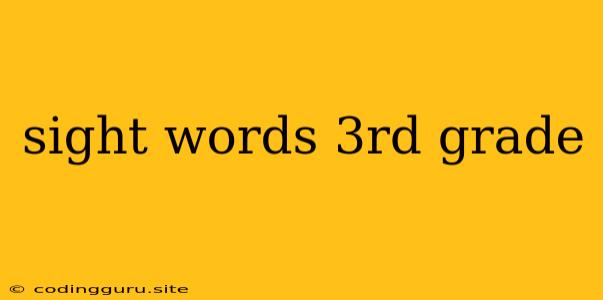Mastering Sight Words in 3rd Grade: A Guide for Parents and Educators
Third grade marks a significant step in a child's reading journey. They are transitioning from learning basic decoding skills to reading more complex texts and developing fluency. Sight words, also known as high-frequency words, are crucial for this development. These are words that appear frequently in written English but don't always follow predictable spelling patterns. Mastering sight words allows children to read more effortlessly and focus on comprehension.
What Are Sight Words?
Sight words are words that children are expected to recognize instantly without having to sound them out. They are words that are commonly used in everyday language and are often encountered in reading materials.
Why Are Sight Words Important in 3rd Grade?
Sight words are essential for third graders because they:
- Improve reading fluency: Recognizing these words quickly allows students to read smoothly and naturally, enhancing their comprehension.
- Boost reading confidence: Knowing sight words automatically gives students a sense of accomplishment and encourages them to tackle more challenging texts.
- Support writing skills: Strong sight word knowledge allows children to write more easily and accurately, as they can readily use these words in their writing.
Common Sight Words for 3rd Grade
Here are some examples of sight words commonly taught in third grade:
- Common: a, and, are, as, at, be, but, can, come, for, go, has, he, her, him, his, how, in, is, it, its, me, my, not, of, on, one, our, see, so, that, the, them, then, there, they, to, was, we, were, what, when, where, who, why, will, with, you
- Less common: after, again, all, also, am, any, because, been, before, both, could, does, down, each, every, few, find, first, from, get, give, had, have, here, hold, into, just, know, like, make, many, more, most, much, new, now, only, over, people, said, should, some, take, tell, their, these, think, through, too, under, use, very, want, well, went, which, while, who, would, write
Effective Strategies for Teaching Sight Words
- Repeated exposure: Use games, activities, and flashcards to repeatedly expose students to sight words. The more they see and hear these words, the faster they will learn them.
- Multisensory learning: Engage multiple senses to help students learn sight words. For example, use colorful flashcards, write words in sand or shaving cream, or create a word wall with visually appealing displays.
- Contextual learning: Encourage students to read books and articles that contain sight words. This helps them see how the words are used in real-life situations.
- Chunking: Break down longer sight words into smaller parts to make them easier to learn. For example, divide "because" into "be" and "cause."
- Personalization: Connect sight words to students' interests and experiences. For example, have them create a story using sight words related to their favorite hobbies.
Fun Activities for Sight Word Practice
- Word Bingo: Create bingo cards with sight words and call out the words. The first player to get five in a row wins.
- Sight Word Concentration: Create pairs of cards with sight words written on them. Players take turns flipping over two cards at a time, trying to find a match.
- Sight Word Scavenger Hunt: Hide sight word cards around the classroom or home. Have students find the cards and read the words.
- Sight Word Relay Race: Divide students into teams and have them race to spell sight words on a whiteboard.
- Sight Word Story Time: Read a story together and have students highlight or circle sight words as they read.
Assessing Sight Word Mastery
- Informal assessments: Observe students as they read aloud or participate in activities. Note which words they recognize instantly and which ones they struggle with.
- Dictation: Dictate sight words to students and have them write them down.
- Word lists: Provide students with a list of sight words and ask them to read them aloud.
Conclusion
Mastering sight words is an essential part of becoming a fluent and confident reader in third grade. By using effective teaching strategies and engaging activities, parents and educators can help students develop the skills they need to succeed. Remember, patience and consistent practice are key to helping children master these important words.
